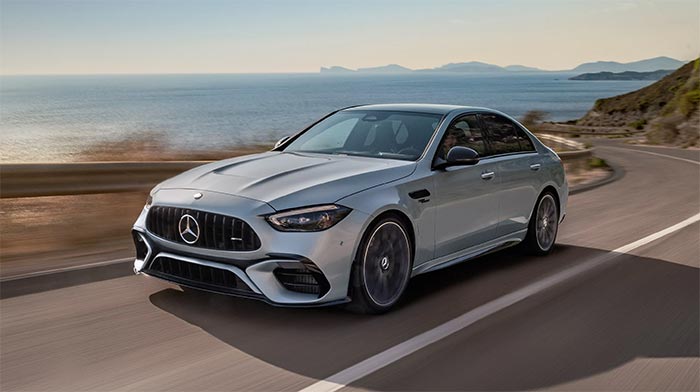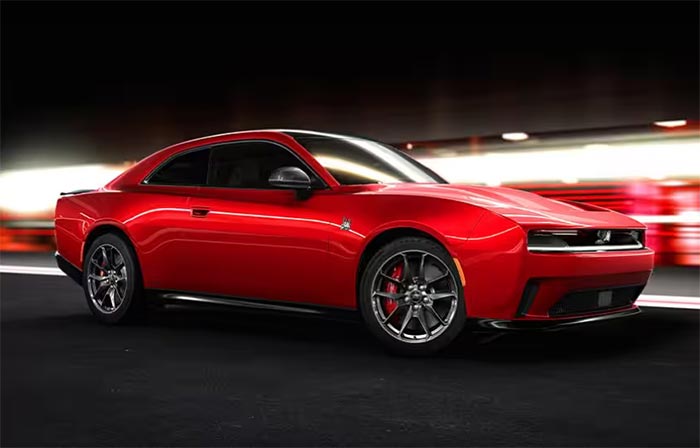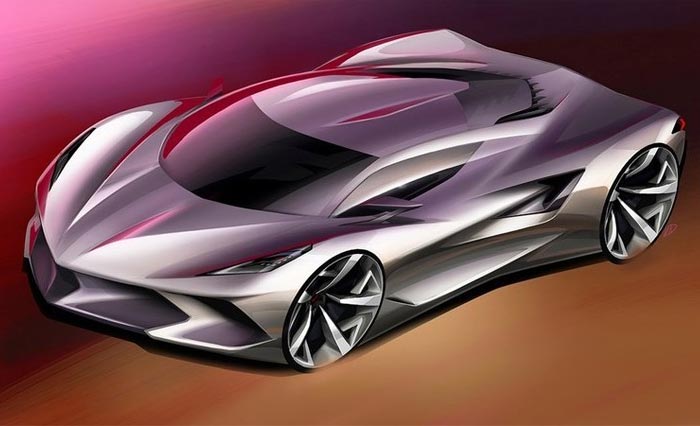Life after V8s. It’s a sobering thought, but it’s also a reality that even the thundering Corvette, its makers, and its customer base will eventually have to contend with. Fortunately, America’s Sports Car and the other icon from across town are the betting favorites to play home to the “last V8 standing.” Not all nameplates that draw so much of their identity from the glory of the bent-eight are so lucky, though. In recent months, we’ve been introduced to two new versions of models that were forced to relinquish their predecessor’s trademark exhaust burble, but they’ve gone about addressing this loss in vastly different ways. These divergent paths to V8 replacement piqued our curiosity about how the Corvette’s massive fan/client network would react to different paths that General Motors could choose for its halo car when the legendary LT engine family reaches the end of the line. Before soliciting your feedback, though, let’s explore these paths and the new cars/case studies that will be treading them in the very near future.
2024 Mercedes-AMG C63
 Photo Credit: Mercedes Benz USA
Photo Credit: Mercedes Benz USA
Surprisingly, the Europeans who adhere most closely to American vehicular sensibility – the madmen at Mercedes’ famed AMG performance wing – have stepped up to become one of the first canaries to enter the mineshaft of V8 substitution. AMG’s pumped-up sedans used to be extremely easy to decipher: model lines like C, E, and S were followed by numbers that represented the number of liters under the hood. When you saw an E55 AMG twenty years ago, you knew that you were looking at an E-Class with a supercharged (Kompressor) 5.5L V8 under its hood. That motor eventually gave way to the naturally-aspirated 6.3(ish)-liter V8 that powered the “63” models (and held the NA horsepower record until the C8 Z06 dropped like a 670-horse nuke) until the age of “downsizing and turbocharging” swept the industry. Suddenly, C63s (the name stuck as the Germans felt that a smaller number would cheapen the new product), et al., were powered by a new 5.5L with twin-turbos and, most recently, a 4.0L V8 strapped to a pair of snails.
For its return this year, the newest AMG C63 (to add further confusion, the “AMG” designation now slides in before the model letter designation and takes the place of “Benz” in the overall nomenclature) is down to half of the cylinders and half of the displacement of the car that it is replacing. That’s right, the ultimate C-Class that has always lorded over the range with eight combustion chambers is moving forward with four-banger power assisted by a rear-mounted battery pack. This system makes a combined 671 HP versus the old 4.0’s 503 rating. On top of that marked improvement in firepower, Mercedes is leaning hard into the “it’s like what we use in Formula1!” angle to try to convince buyers that a 2.0L four can be premium. Will it work, or did they just solidify the market for four-liter cars in perpetuity? Time will tell!
2024-25 Dodge Charger
 Photo Credit: Dodge.com
Photo Credit: Dodge.com
Arguably, the car, and even the brand, most closely associated with V8 antics over the past decade has been Dodge and its Charger/Challenger twins. Their marketing literally revolved around tire smoke and exhaust pipes roaring over a Mötley Crüe soundtrack. Because of this, the new Charger (the Challenger name has been re-retired) faces what will likely be the rockiest road out of the V8 era of any car in the world. To answer the bell, Dodge has set up a two-fronted attack consisting of a pure EV Charger (great name for an electric car, no?) Daytona and a traditional ICE-powered “Sixpack” version that will hit the scene some six months after the electric one when both will also receive options for two or four-door bodies. The all-electric Daytona debuts with a base R/T trim that outmuscles the old 6.4L “Apache” V8 with a stout 496 HP and a Scat Pack that throws down a Corvette Z06-equaling 670 ponies, with even more powerful – read: Hellcat killers – varieties waiting in the wings.
The gassers will debut for the ’25 model year and they earn the Sixpack name with six cylinders instead of the triple two-barrel carbs that were famous for their work on the old 440. What Stellantis’ new 3.0L twin-turbo “Hurricane” inline-six gives up in swagger, it makes up for in power and, on paper, efficiency. The only combustion engine available features two states of tune, just like the plug-in. The base or S.O. (for Standard Output) Hurricane makes a Cheech and Chong-approved 420 ponies, while the H.O. (you don’t need that spelled out, do you?) pushes 550 horses – 10 more than it makes in its new RAM application and an increase of 40 over the one in the Grand Wagoneer.
So, unlike AMG, Dodge has launched two distinct probes: the first is testing how customers react to a Charger with fewer cylinders, both more powerful and more efficient than the corresponding Hemis. The second asks if anybody will step up for one that’s even more powerful but runs on a form of energy that is seen as the enemy by most car enthusiasts. At Dodge, the new Chargers will have another war on two fronts ahead of them, simultaneously competing with each other AND with their beloved V8 ancestors.
The Corvette’s Post-V8 Options
 Photo Credit: Vlad Kapitonov / GeneralMotorsDesign (Instagram)
Photo Credit: Vlad Kapitonov / GeneralMotorsDesign (Instagram)
Before giving up on the V8, the ‘Vette is likely to call an all “E-Ray” play that sprinkles hybrid power all over the portfolio. After that intermediate step, GM will have a few ways to proceed and, thanks to these guinea pig brands – that you can bet are being watched like hawks – they’ll have some blueprints to work with:
- AMG’s best-of-the-world option: Keep ICE through a smaller engine that is enhanced with forced induction and a sizable battery pack.
- The Charger’s best-of-both-worlds solution: offer an electric option AND an ICE option with turbos and fewer cylinders that sits lower in the pecking order (maybe even under the “Blue Flame” moniker).
- The newly Tadge-less Corvette Team can rip off the band-aid and ditch internal combustion altogether to join Mrs. Barra’s corporate vision of an all-electric future with a more affordable take on the record-smashing Rimac Nevera hypercar.
Your Choice as a Consumer
In the end, we are still living in a capitalistic society and the success of whatever decision General Motors makes rests in the hearts, minds, and wallets of you, the end user. So, the question falls to you: when there isn’t a V8 option left wearing the Crossed Flags in Chevrolet showrooms, what is most likely to earn your dollars: one of the three options above, or will you shift gears and become someone that only shops for used V8 Corvettes? We are very interested to check Corvette Nation’s temperature on this one; vote and chime in below, GM might be listening!
Related:
[POLL] What Do You Think of This Purple Chevrolet Traverse Exterior for the C8 Corvette
[POLL] HOT OR NOT? Should Chevy Offer Purple for the C8 Corvette?
[POLL] Time For The Corvette Z06 To Get Back To The ‘Ring
Subscribe Now:
-

![[POLL] Which New Corvette Will Earn Your Business When the V8 is Phased Out?](https://www.corvetteblogger.com/images/content/2024/041924_7.jpg)



None! I’ve owned 7 Corvettes, from 1977 to 2014. I currently own a Lime Rock Green convertible and plan to donate it to the Corvette Museum when I die. I WILL NOT BUY AN EV ANYTHING! I did not drink the Kool Ade and will walk before I sit my butt in an EV!
When I took delivery of my ’23, I knew that she will likely be the last of the pushrod V-8 Corvettes. Perhaps my premonition is turning out to be true…
Here is an idea. Resurrect and update the Oldsmobile 4.0L DOHC Aurora V8. Keep the cross-plane crank. I’ve played with many Auroras and Northstars; piped, cammed & tuned right, you would swear they’re a savage 6.2L LT2 based on their sound alone. A buddy and I massaged 455hp out of one that got grafted into a Camaro in 1999, and it worked as a daily driver. At the time, nobody believed us when we said it was a 4.0L plant! Integrate a spry hybrid electric drive and a 600-plus HP total output will not be too big an ask.
Also, lest we forget, the Aurora V8 is no stranger to endurance racing at Daytona or Sebring (it was GM’s bullet in WSC and GTS-1 before the C5.R)…and it actually sounded good as an IndyCar engine when the NA era started in the IRL in 1997.
Last but not least, it’s time to start integrating more composites into the chassis. The price of raw materials, namely carbon fiber, is almost down fiberglass levels!
C9 will have some big shoes to fill, no matter what path!
We are forgetting that synthetic gasoline is a real possibility.
This is using carbon from the atmosphere, mixed with hydrogen to create gas. Aramco and Shell both have factories making it in small batches, with plans to upscale. It works. And as
I see it, there will need to be supplies of this fuel in the pipeline, so to speak. This means a measurable percentage of carbon stored in a liquid form and constantly being recycled in a closed loop. Can you say carbon neutral? Can you say carbon negative?
The concept has plants placed in warm, sunny and windy areas near water. Peru, Spain and Saudi Arabia so far. These areas provide for ample solar and wind power to keep the factories operating.
And before you all whine about the cost of green energy, remember this… sure, nothing is perfect, but when a coal or oil fired plant is closed, there is so much EPA toxicity, it ain’t funny. So for the minor impact of recycling solar panels or dealing with windmill blades, that seems cheap. I don’t even want to discuss nuclear power.
California, during daylight hours, is producing some 80% of its electric power from renewables… solar, wind, geo-thermal and hydro… That’s impressive.
if Cal gets 80% from renewables , what do they do at night ? probably, it is Gov mandated that Cal Electric (or whoever) have the facilities to produce 100% demand whether it is needed or used. So, the users pay for 2 sources of power. I’m waiting on an Eray..lol..safe travels 2 all
There’s no need to abandon an inexpensive, plentiful, easy to store, easy to transport means of short and long range transportation for a short range, fussy to “fuel”, expensive electric car. I guess if you slept through 2016-2020 you may have have missed that fracking and shale oil production can provide enough fossil fuel to last us thousands of years. In thousands of years perhaps scientists will make better electric cars (that work in all weather conditions). But until then… use whatever you prefer. Being able to keep your free “Consumer Choice” is very much dependent upon who wins the next presidential election as the two candidates have very different policies.
I have to wonder if egalitarian government “masterminds” trying to force us into electric cars have really thought things through. I don’t believe that there will ever be affordable, reliable electric cars for the used car market that low and middle income people can afford and use to get to work. The remaining life of a used battery powered car is very dependent upon how hard it was driven and how “hard” it was charged. “Fast” chargers shorten life. One never knows when a used battery will crap out. Today fairly reliable, used gasoline powered cars can be bought for $3000 to $5000. Are reliable, used EVs that cheap? If lower income people can’t get to work, unemployment goes up. Businesses fail. Even rich guys need to think about this as they see their investments take a dump. The economy can’t do without low wage service and delivery people. One has to think BIG before doing big changes in transportation and destroying a nation’s economy.
I was one of the overwhelming majority who voted for sticking with used Corvettes. However since it looks like the C9 is destined to be all electric, I can only hope the Corvette engineers and stylists will take advantage of not having a mid mounted V8 engine to style the next gen car around. I would like to see them give us an all new radical looking Corvette with some of the best traditional Corvette styling cues and a return to the Corvette’s iconic long hood and short rear deck styling so we will have a new Corvette that looks like a Corvette should look. Maybe then I will buy one more new Corvette in my lifetime. This is my wish and 2 cents worth coming from a lifelong Corvette enthusiast and 8 time Corvette owner.
None. What a stupid article. I bought one of the last big engine Lexus RCs as they transition to turbo 4s. It sits next to my M7 Front Engine GS.
This argument is just silly. Whenever the transition to all EV’s come true all of us complainers will probably be gone. My son will enjoy my C8 Z06 and I will just be a memory. If I survive long enough to see this full transition to EV’s I will undoubtedly miss the sound of both my small block V8 and especially the roar of my flat plane LT6. However, I am not the pessimist as most of the above. I have tested several EV powered cars and SUV’s. Some production units some pre-production. I do not see these as bad as so many have said, I just see them as
different. As I have always said, I just along for the ride. See you in Bowling Green.
I care not for the purist crowd. The V8 purists sound like Immortan Joe’s War Boys.
Either a 4.6L DOHC V6 TT or a 3.1L DOHC I4 twin-scroll turbo would be the logical choice. Both would effectively be “chopped down” versions of the LT2.
I would love to see GM develop the I4 into 3.0L + and boosted to the 500+ hp range. Considering what Koenigsegg is doing with a 2.0L and freevalve, this doesn’t seem like too much of a longshot–especially if GM goes up to something like 4L.
Either way, it had better have hybrid drive. 70 years of RWD only Corvettes to choose from–and I don’t want any of those.
@IPD, if you’re not a Corvette purist in some way… then clearly you’re not a Corvette person!
Take that 4 cylinder crap elsewhere. Nothing less than 6 cylinders should touch it be in any sporting, performance car!!!
None of the above, as my bones weaken, my joints harden, my sight grows dim, my teeth become soft, I will be looking forward to my wife taking over the driving responsibilities.
Our next vehicle will be a new Japanese, preferably a Toyota, EV that I can easily negotiate the passenger side door.
Meanwhile, resting in my garage next to the new EV will be my old “front engine” C7 2/2016 base-model, triple black immaculate Corvette.
Please note: I have a financial interest in Toyota Motor Company.
Many thanks,
Ray
I find it ironic that sports/exotic vehicles are really the best use of the EV concept given they mostly sit in their garages awaiting the next Cars and Coffee, or OMG a daily commute, but just a tiny few are road-trippers where range anxiety will always be an issue. And their owners seem to be the ones most adamant about keeping those rumbling V8s. Better drive ’em before fuel prices go to unfathomable heights due to lack of demand created by EV World.
EV sports/exotic vehicles usually end up heavier than conventional propulsion. It’s actually EVs that are not in popular demand. In the last quarter Ford just lost another $1.5B in their EV division due to lack of EV consumer demand. The good thing about fossil fuels is that widespread application of fracking and shale oil extraction proven during 2016 to 2020 has insured that there is an abundant source of energy for transportation and other uses that will last for thousands of years. Mining expensive rare earth minerals for EVs, not so much… Ever see how much water is required to extract a little bit of lithium? It turns out that much of that is done in parts of the world where water is quite scarce – necessary for human survival in those locations. But for some people, you have break some eggs to make an omelette.